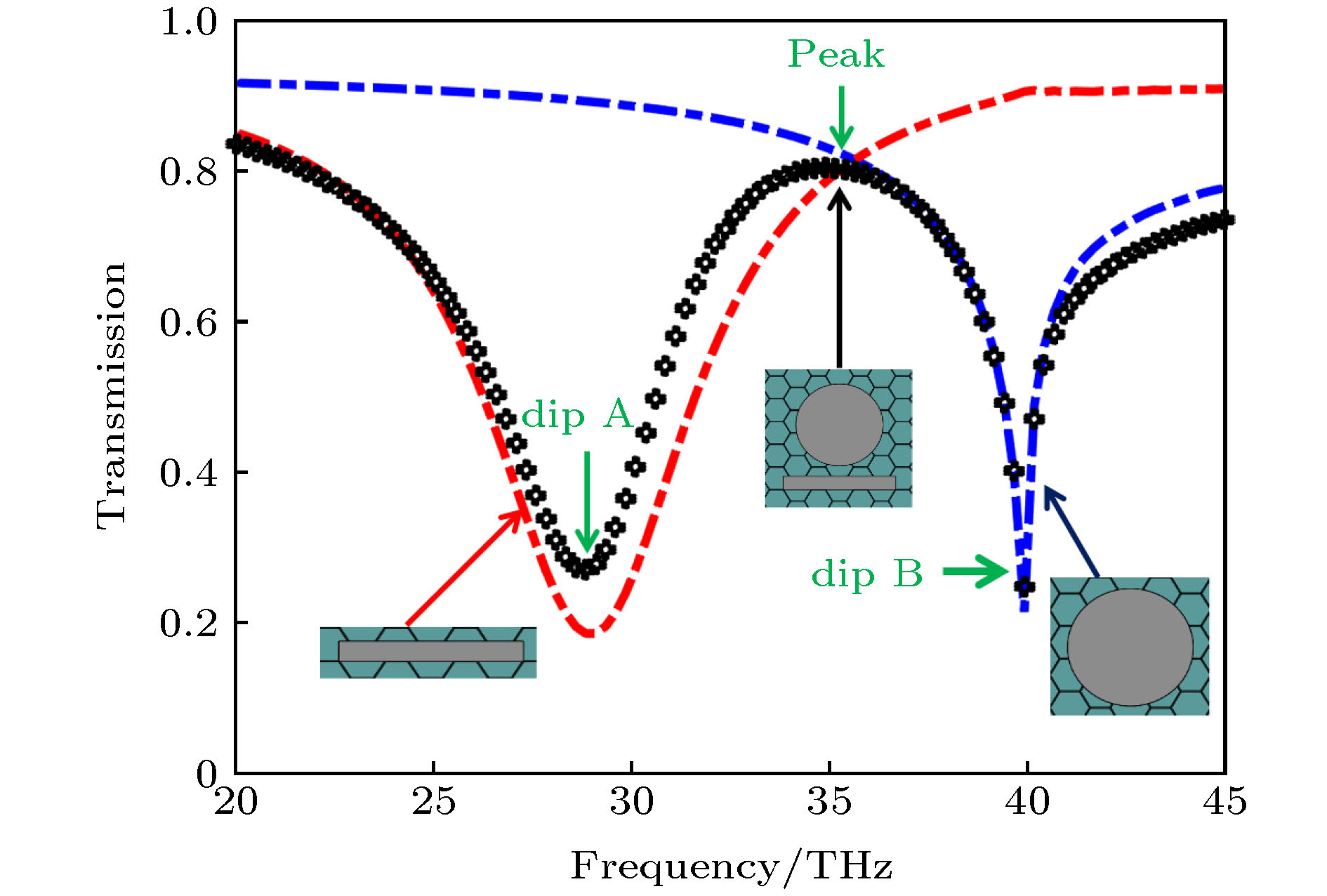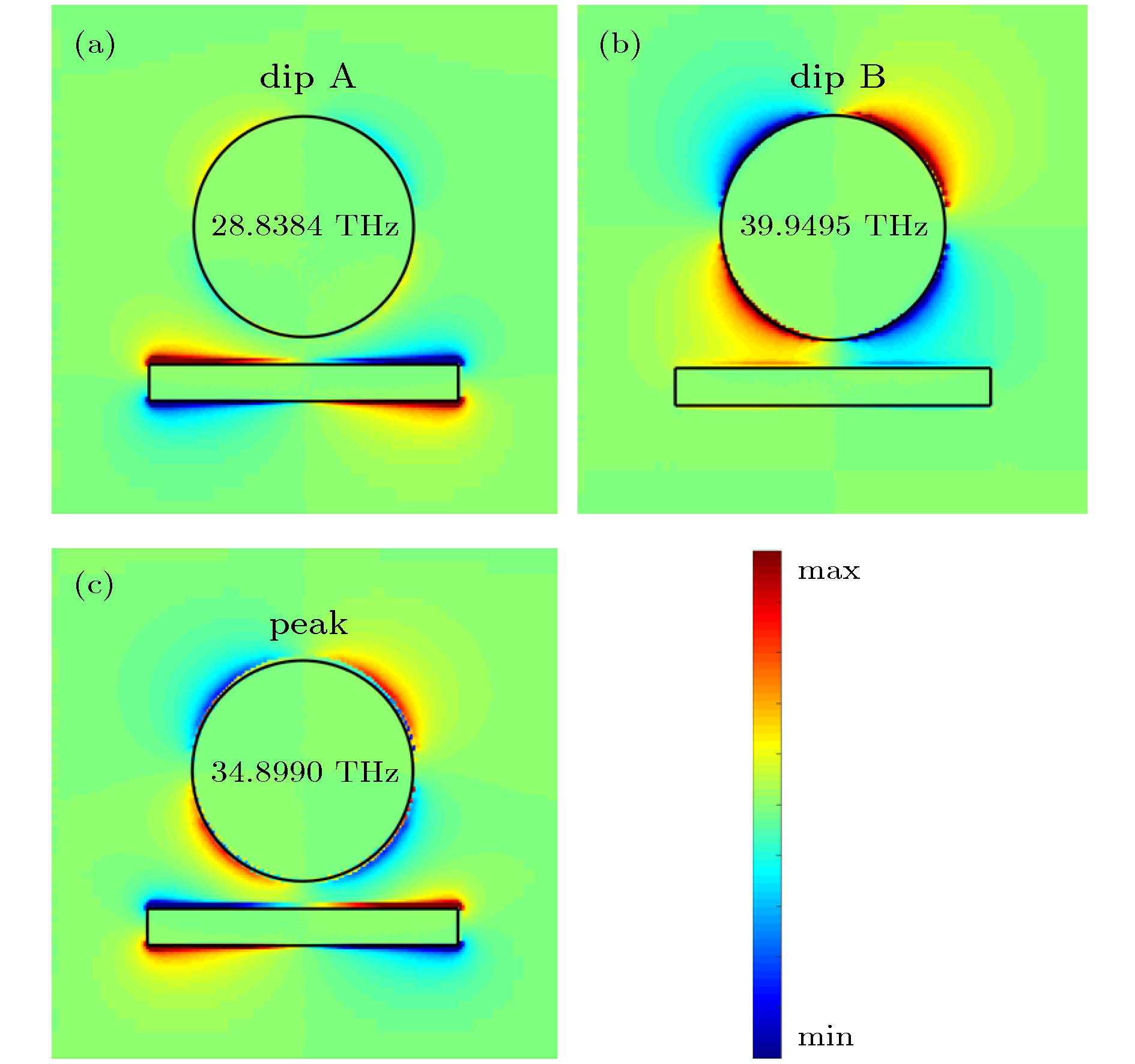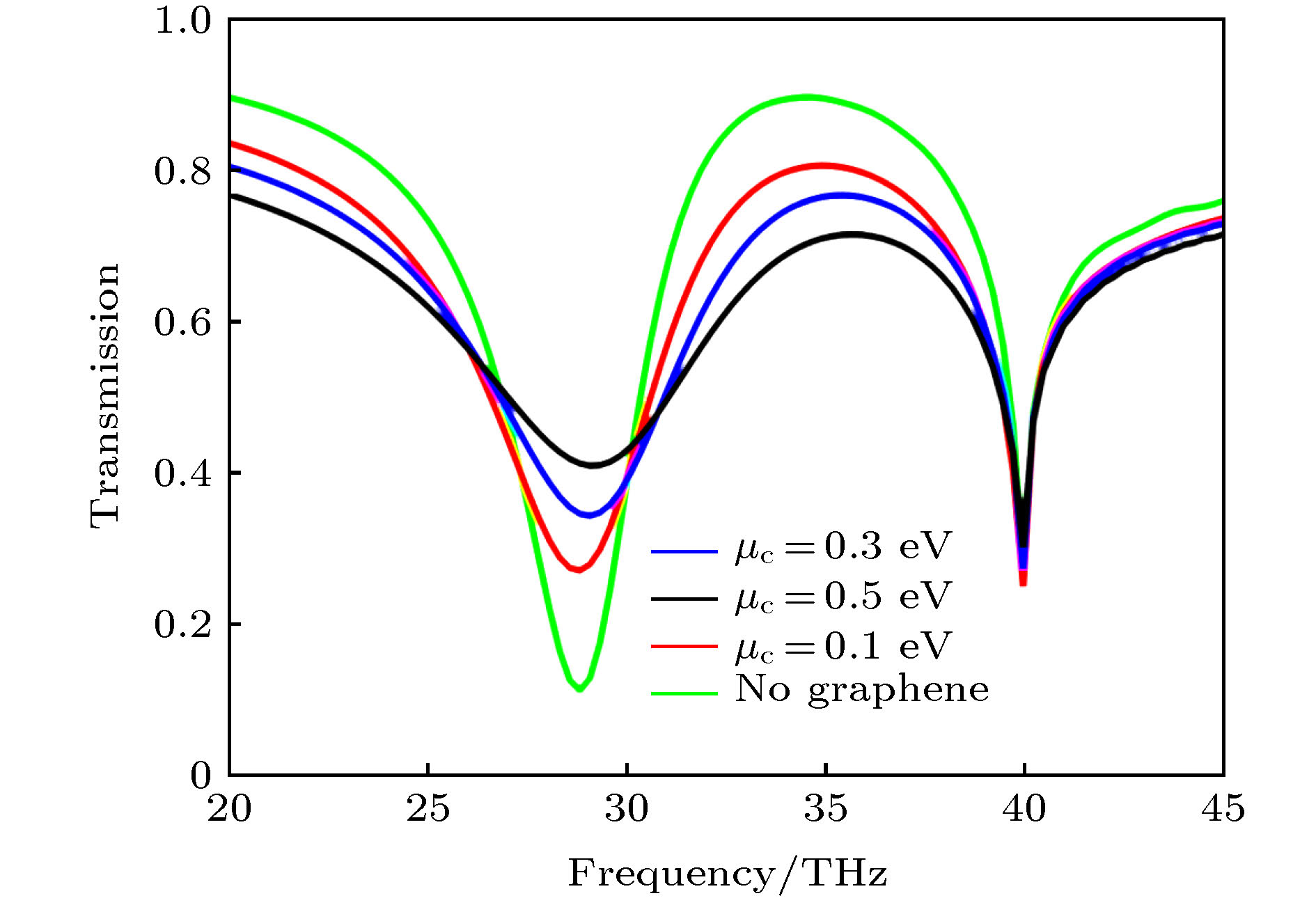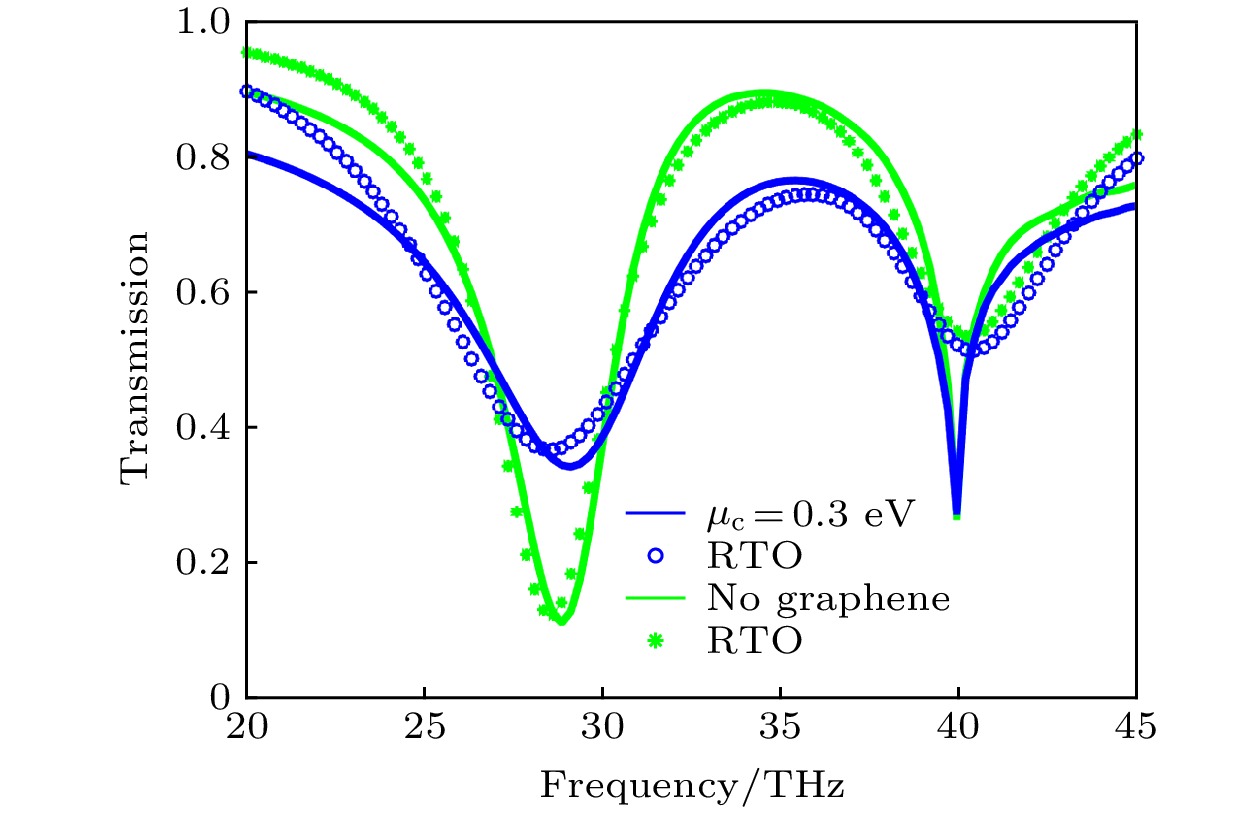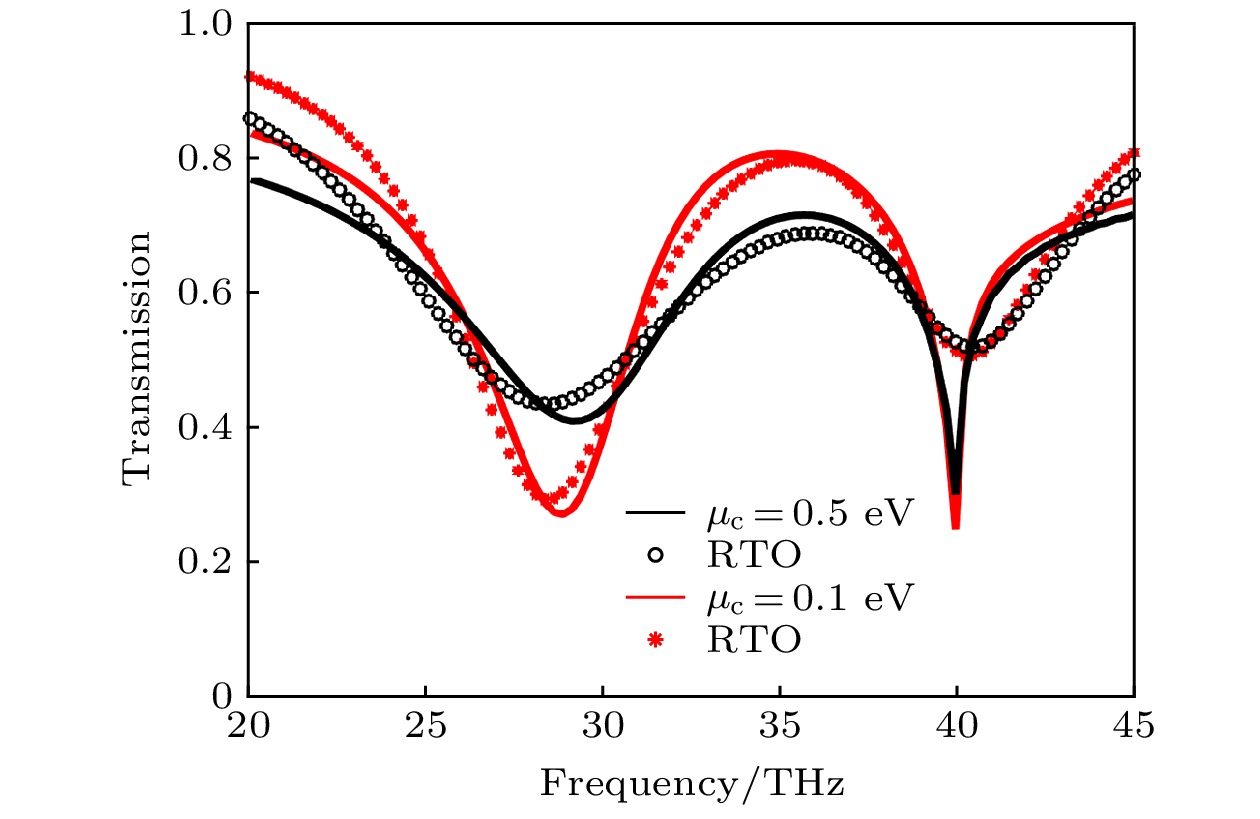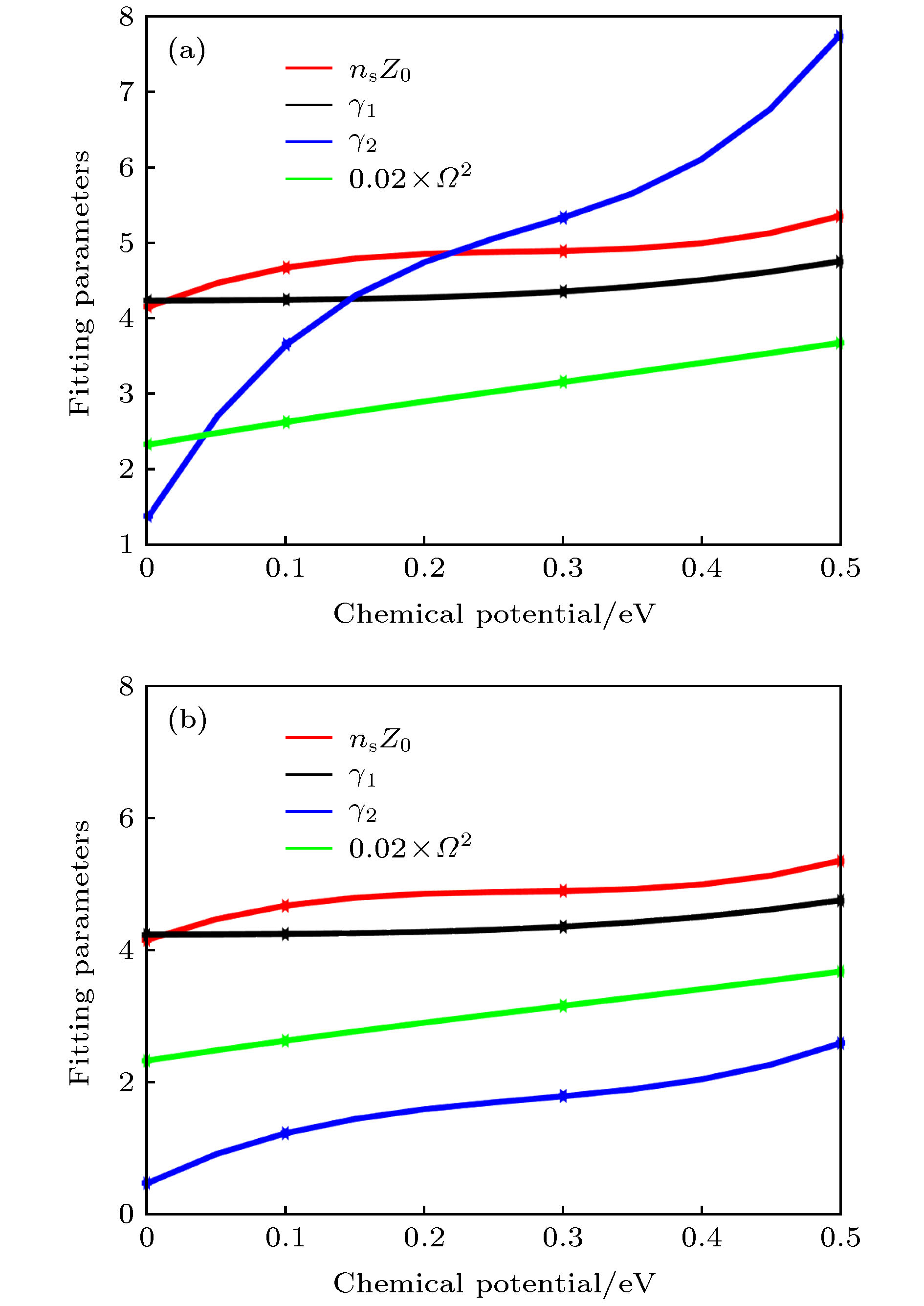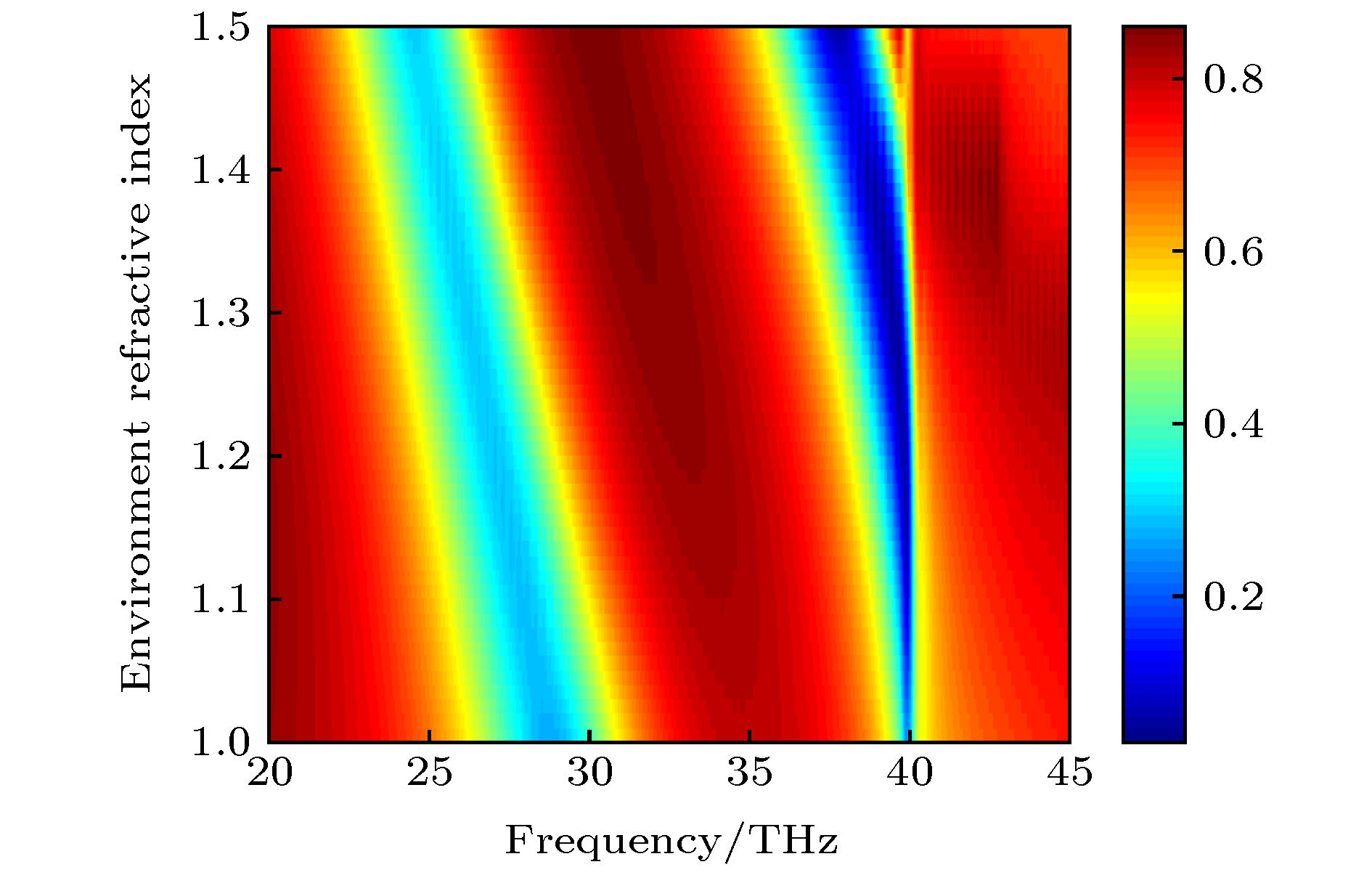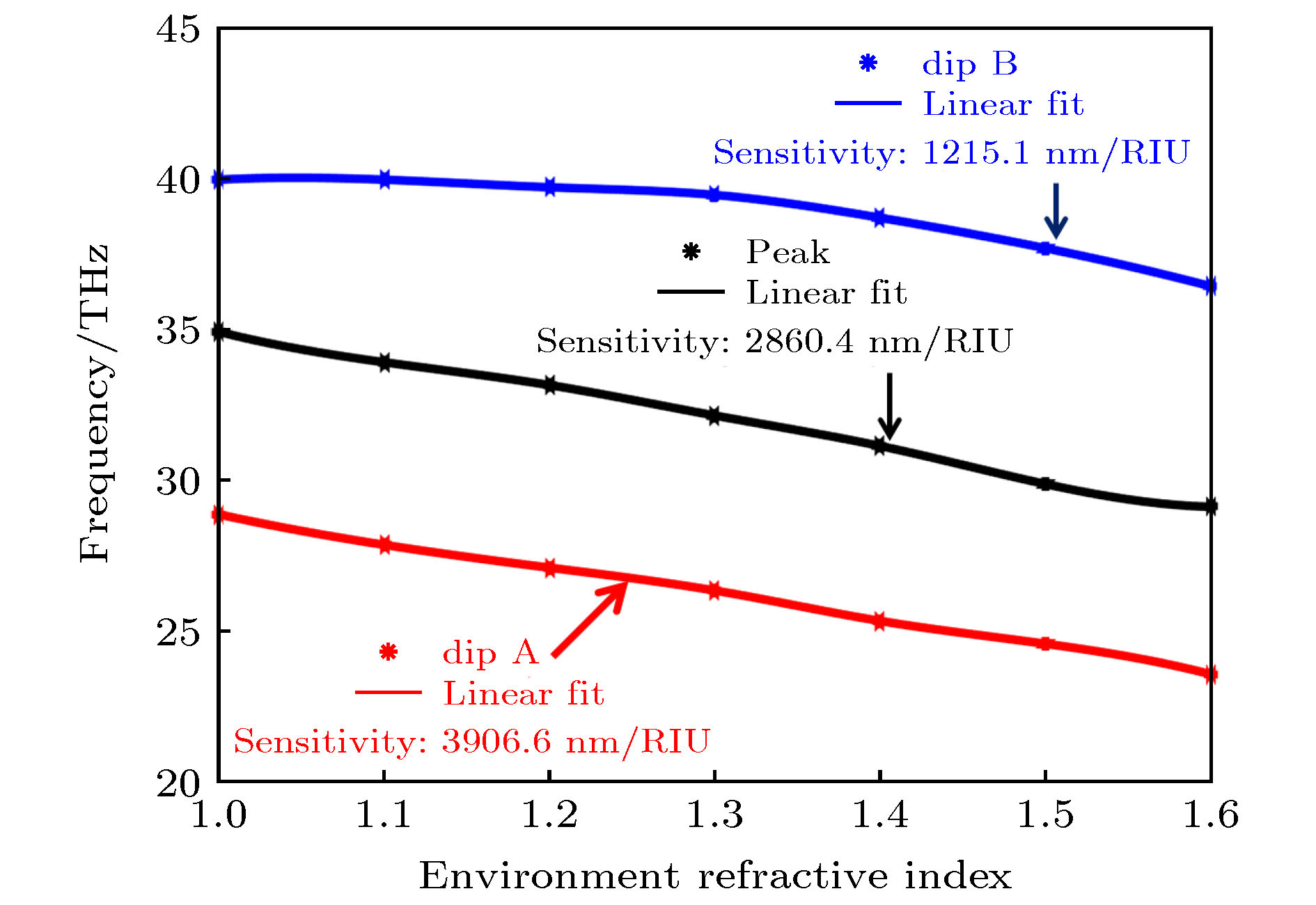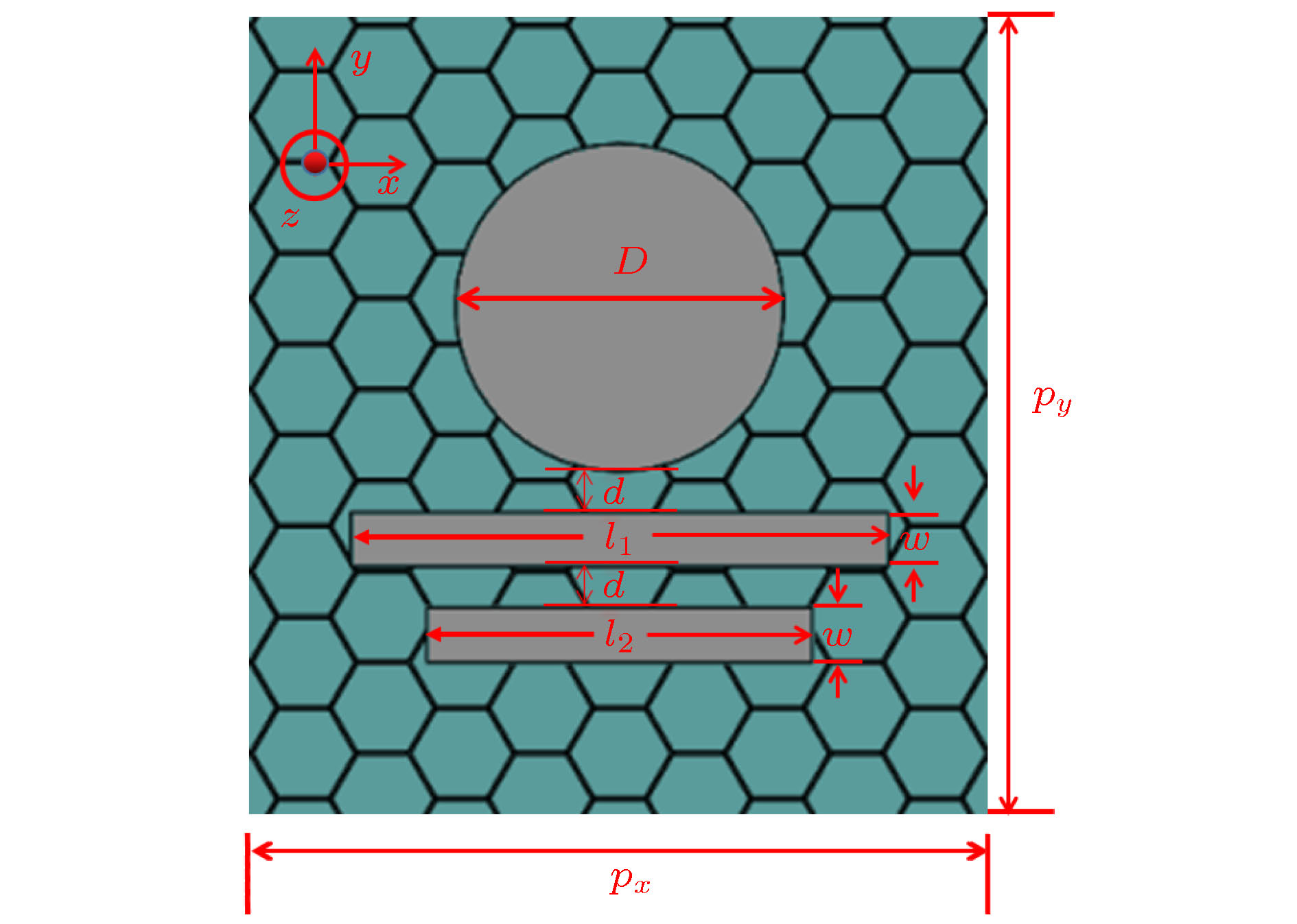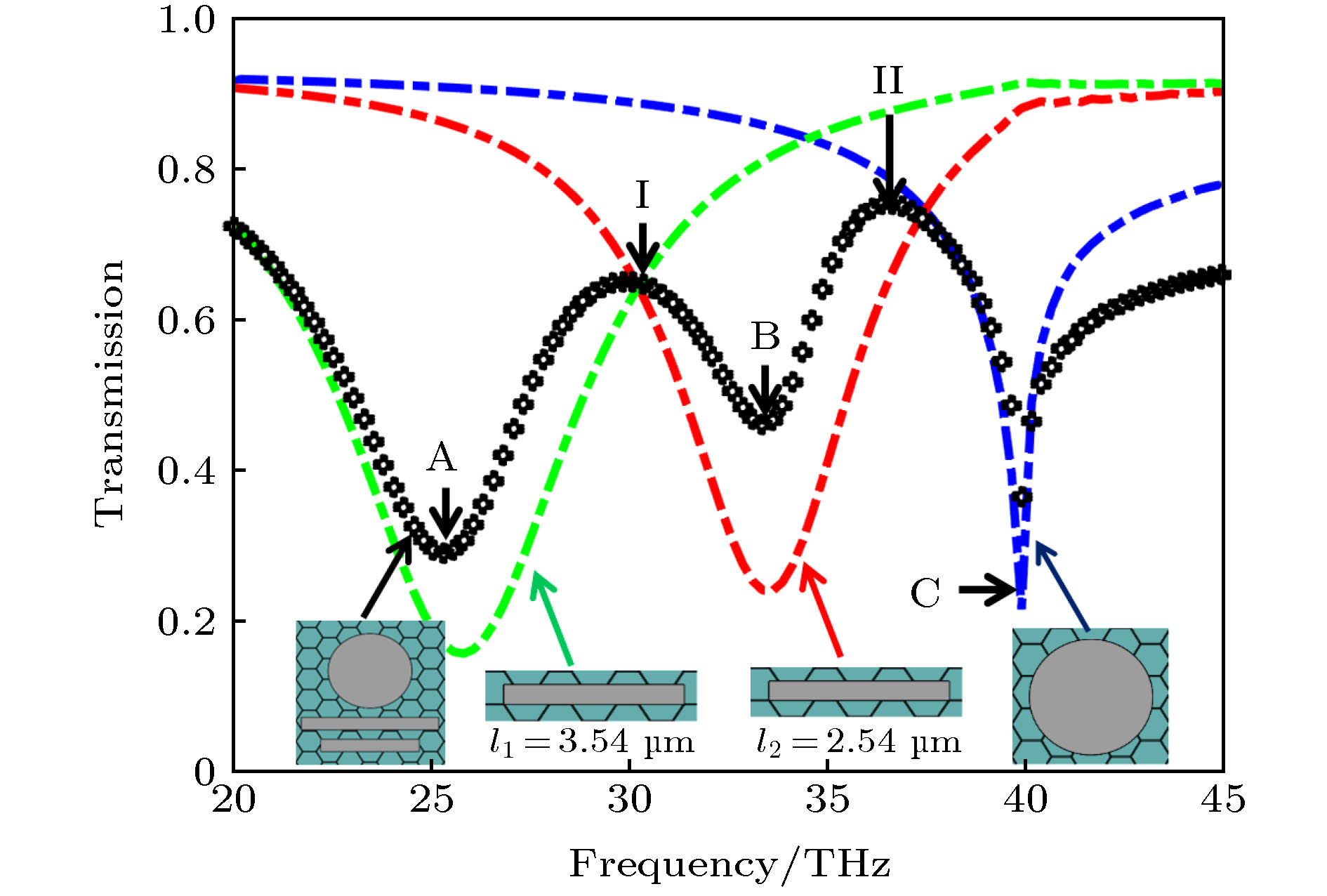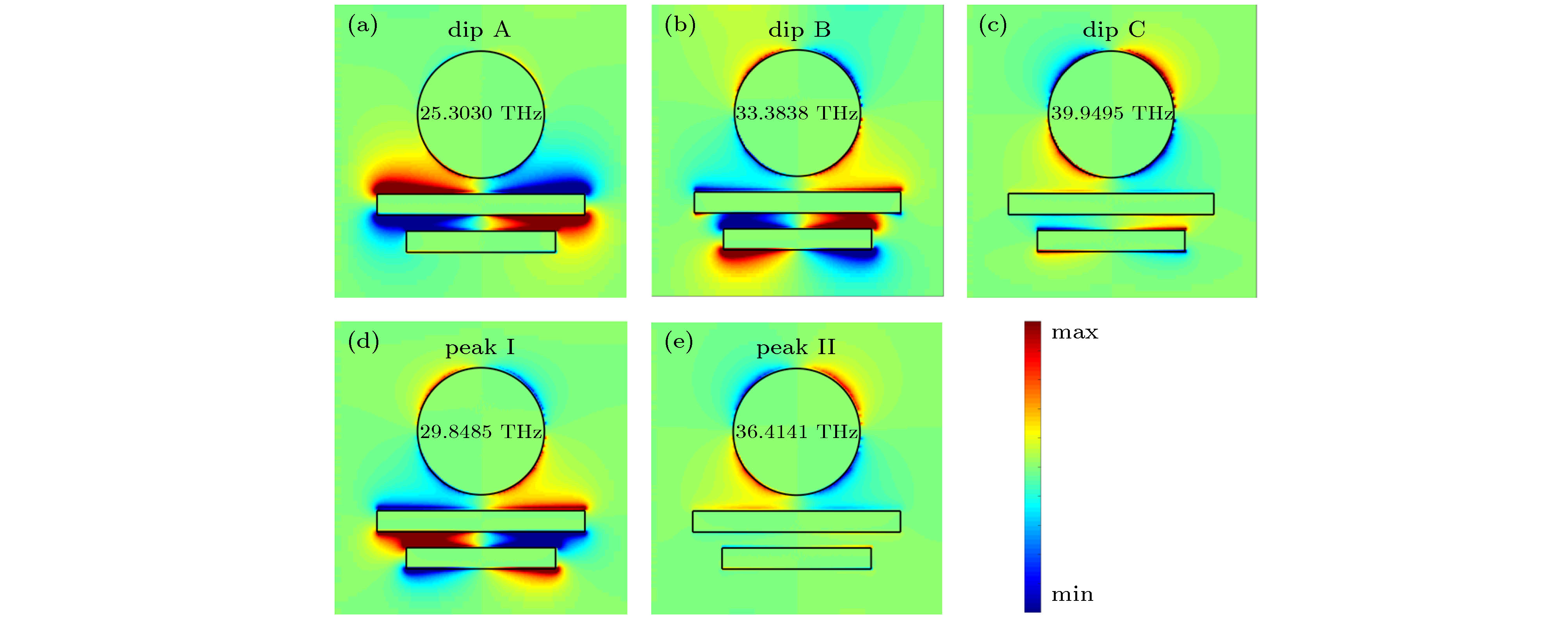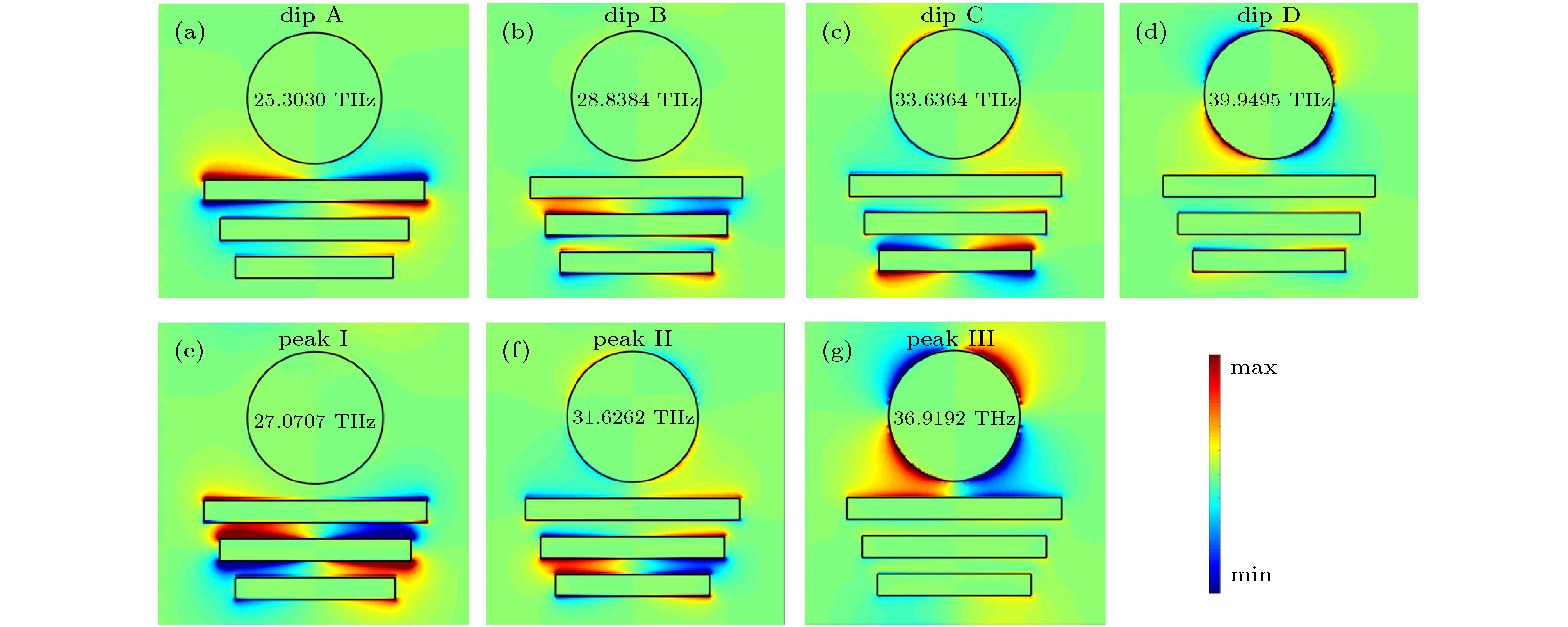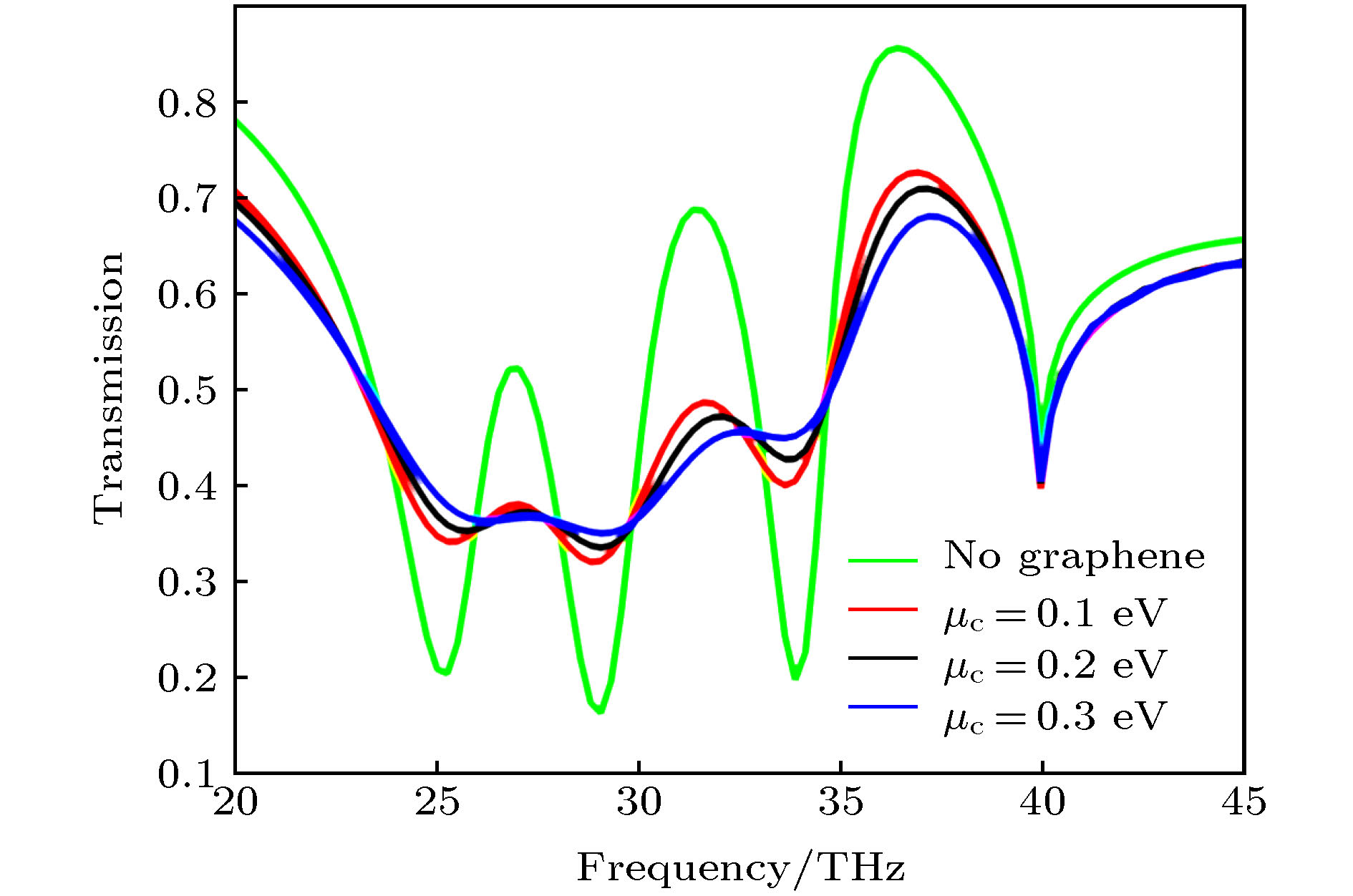-
提出了基于银纳米棒、银纳米盘和石墨烯耦合的多频段等离激元诱导透明(PIT)电磁模型, 通过时域有限差分和辐射双振荡器(RTO)模型从数值计算和理论研究两方面分析了模型的电磁特性. 结果表明: 由于银纳米棒与银纳米盘、银纳米棒与银纳米棒之间的明模-明模耦合, 可以实现在单频段PIT效应的基础之上, 进一步产生双频段和三频段的PIT效应. 其次, 通过改变石墨烯的化学电位势, 可以在单频段、双频段和三频段PIT模型中同时实现谐振频率和透射振幅的可调性. 当化学势增大时, 各频段PIT窗口的谐振频率将会逐渐增大, 发生蓝移. 此外, 随着化学势增加, 银盘和银棒表面电荷数会不断增加、表面电场将不断增强. 同时, 银盘和银棒、银棒和银棒之间的耦合强度也将逐渐增强. 因此, 各频段PIT的透射振幅将会逐渐减小, 振幅调制深度逐渐增大. 进一步研究了单频段PIT模型的传感特性, 该模型随背景材料折射率变化的灵敏度达到了3906.6 nm/RIU. 这为多频带滤波、超灵敏传感器的设计提供了理论参考.
-
关键词:
- 多频段等离激元诱导透明 /
- 石墨烯 /
- 时域有限差分法
In this paper, we have proposed a multiband plasmon-induced transparency (PIT) hybrid model based on silver nanorods, silver nanodisk and graphene. The electromagnetic properties are numerically and theoretically studied in this paper. The research results show that using the bright-bright mode coupling between silver nanorods and silver nanodisk, based on the weak hybridization effect induced by the detuning of each bright mode unit, the single-band, dual-band and triple-band PIT effects can be achieved. By changing the chemical potential of graphene, the tunability of the resonant frequencies and transmission amplitude can be achieved simultaneously in each PIT model. When the chemical potential of graphene is 0 in each of the three PIT models, that is, without graphene, the resonant frequencies of its transparent window is the smallest. As the chemical potential of graphene increases from 0 to 0.5 eV, the resonant notches of the transparent peak in all three PIT models are both enhanced and blue shifted. Especially, when the chemical potential is 0.5 eV, the absolute increment of resonance notch generated by the sing-band PIT transparent window is $\Delta f = 1.01$ THz and the relative increment is 2.91% while the largest absolute increment of resonance notch generated by the dual-band PIT transparent window is$\Delta f = 1.77$ THz and the largest relative increment is 5.97%. In the next place, when the chemical potential is 0.3 eV, the absolute increment of resonance notch generated by the triple-band PIT transparent window is$\Delta f = 1.26$ THz and the relative increment of the window is 4.02%.On the other hand, when graphene is existent in none of the three models, the resonance between silver nanodisk and silver nanorods, and the resonance between silver nanorods and silver nanorods are the weakest and the transmission amplitude of transparent window is the strongest in each of the three PIT models. Thereafter, with the increase of chemical potential, the number of surface charges on the silver nanodisk and silver nanorods increases and the intensity of electric field is enhanced. At the same time, the coupling strength between silver nanodisk and silver nanorods, and the coupling strength between silver nanorods and silver nanorods are also gradually enhanced. As a result, the transmission amplitude of each PIT model will gradually decrease. Especially, when the chemical potential is 0.5 eV, the amplitude modulation depth of the single-band PIT transparent peak is 20.2% and the amplitude modulation depth of the two transparent windows in dual-band PIT model are 31.2% and 24.2% respectively. In addition, when the chemical potential is 0.3 eV, the amplitude modulation depths of the three transparent windows in triple-band PIT model are 29.8%, 33.8%, and 20.5%. Finally, the sensing properties of the single-band PIT model are further investigated. The results show that the sensitivities of the model with refractive index of different background materials reach 3906.6 nm/RIU all, which provides a theoretical reference for the design of multiband filtering and ultrasensitive sensors. [1] Tassin P, Zhang L, Koschny T 2009 Phys. Rev. Lett. 102 4
[2] Li H J, Wang L L, Liu J Q 2013 Appl. Phys. Lett. 103 211104
 Google Scholar
Google Scholar
[3] Liu N, Langguth L, Weiss T 2009 Nat. Mater. 8 9
 Google Scholar
Google Scholar
[4] Papasimakis N, Fu Y H, Fedotov V A 2009 Appl. Phys. Lett. 94 211902
 Google Scholar
Google Scholar
[5] Safavi-Naeini A H, Alegre T P M, Chan J, Eichenfield M, Winger M, Lin Q, Hill J T, Chang D E, Painter O 2011 Nature 472 69
 Google Scholar
Google Scholar
[6] Qin M, Wang L L, Zhai X 2018 IEEE Photonic. Tech. L. 30 11
 Google Scholar
Google Scholar
[7] Ding J, Arigong B, Ren H 2014 Sci. Rep. 4 1
[8] Xiao S Y, Wang T, Liu T T 2018 Carbon 126 271
 Google Scholar
Google Scholar
[9] Shi C Y, He X Y, Peng J 2019 Opt. Laser Technol. 114 28
 Google Scholar
Google Scholar
[10] Ma Q C, Zhan Y W, Hong W Y 2018 Nanomaterials 9 7
 Google Scholar
Google Scholar
[11] Wei B Z, Jian S S 2018 Plasmonics 13 6
[12] Liu T T, Zhou C B, Cheng L 2019 J. Opt. 21 3
[13] Sun C, Dong Z W, Si J N 2017 Opt. Express 25 1242
 Google Scholar
Google Scholar
[14] Dong Z W, Sun C, Si J N 2017 Opt. Express 25 12251
 Google Scholar
Google Scholar
[15] 王越, 冷雁冰, 王丽 2018 物理学报 67 097801
 Google Scholar
Google Scholar
Wang Y, Leng Y B, Wang L 2018 Acta Phys. Sin. 67 097801
 Google Scholar
Google Scholar
[16] Lao C D, Liang Y Y, Wang X J 2019 Nanomaterials 9 171
 Google Scholar
Google Scholar
[17] Wang X J, Meng H Y, Deng S Y 2019 Nanomaterials 9 385
 Google Scholar
Google Scholar
[18] Zhang X B, Wang G Q, Zhang L 2019 Crystals 9 146
 Google Scholar
Google Scholar
[19] Cen H F, Wang F Q, Liang R S 2018 Opt. Commun. 420 78
 Google Scholar
Google Scholar
[20] Hu X G, Yuan S, Armghan A 2017 J. Phys. D: Appl. Phys. 50 025301
 Google Scholar
Google Scholar
[21] Zhang S, Genov D A, Wang Y 2008 Phys. Rev. Lett. 101 047401
 Google Scholar
Google Scholar
[22] Berardi S Z, Rusen Y M, Kelly M 2012 Nat. Commun. 3 780
 Google Scholar
Google Scholar
[23] Habib M, Rashed A R, Ozbay E 2018 Opt. Mater. Express 8 1069
 Google Scholar
Google Scholar
[24] Shu C, Chen Q, Mei J 2019 Mater. Res. Express 6 055808
 Google Scholar
Google Scholar
[25] Zhang Z J, Yang J B, He X 2018 RSC Adv. 8 27746
 Google Scholar
Google Scholar
[26] Liu Y, Zhong R B, Lian Z 2018 Sci. Rep. 8 2828
 Google Scholar
Google Scholar
-
-
[1] Tassin P, Zhang L, Koschny T 2009 Phys. Rev. Lett. 102 4
[2] Li H J, Wang L L, Liu J Q 2013 Appl. Phys. Lett. 103 211104
 Google Scholar
Google Scholar
[3] Liu N, Langguth L, Weiss T 2009 Nat. Mater. 8 9
 Google Scholar
Google Scholar
[4] Papasimakis N, Fu Y H, Fedotov V A 2009 Appl. Phys. Lett. 94 211902
 Google Scholar
Google Scholar
[5] Safavi-Naeini A H, Alegre T P M, Chan J, Eichenfield M, Winger M, Lin Q, Hill J T, Chang D E, Painter O 2011 Nature 472 69
 Google Scholar
Google Scholar
[6] Qin M, Wang L L, Zhai X 2018 IEEE Photonic. Tech. L. 30 11
 Google Scholar
Google Scholar
[7] Ding J, Arigong B, Ren H 2014 Sci. Rep. 4 1
[8] Xiao S Y, Wang T, Liu T T 2018 Carbon 126 271
 Google Scholar
Google Scholar
[9] Shi C Y, He X Y, Peng J 2019 Opt. Laser Technol. 114 28
 Google Scholar
Google Scholar
[10] Ma Q C, Zhan Y W, Hong W Y 2018 Nanomaterials 9 7
 Google Scholar
Google Scholar
[11] Wei B Z, Jian S S 2018 Plasmonics 13 6
[12] Liu T T, Zhou C B, Cheng L 2019 J. Opt. 21 3
[13] Sun C, Dong Z W, Si J N 2017 Opt. Express 25 1242
 Google Scholar
Google Scholar
[14] Dong Z W, Sun C, Si J N 2017 Opt. Express 25 12251
 Google Scholar
Google Scholar
[15] 王越, 冷雁冰, 王丽 2018 物理学报 67 097801
 Google Scholar
Google Scholar
Wang Y, Leng Y B, Wang L 2018 Acta Phys. Sin. 67 097801
 Google Scholar
Google Scholar
[16] Lao C D, Liang Y Y, Wang X J 2019 Nanomaterials 9 171
 Google Scholar
Google Scholar
[17] Wang X J, Meng H Y, Deng S Y 2019 Nanomaterials 9 385
 Google Scholar
Google Scholar
[18] Zhang X B, Wang G Q, Zhang L 2019 Crystals 9 146
 Google Scholar
Google Scholar
[19] Cen H F, Wang F Q, Liang R S 2018 Opt. Commun. 420 78
 Google Scholar
Google Scholar
[20] Hu X G, Yuan S, Armghan A 2017 J. Phys. D: Appl. Phys. 50 025301
 Google Scholar
Google Scholar
[21] Zhang S, Genov D A, Wang Y 2008 Phys. Rev. Lett. 101 047401
 Google Scholar
Google Scholar
[22] Berardi S Z, Rusen Y M, Kelly M 2012 Nat. Commun. 3 780
 Google Scholar
Google Scholar
[23] Habib M, Rashed A R, Ozbay E 2018 Opt. Mater. Express 8 1069
 Google Scholar
Google Scholar
[24] Shu C, Chen Q, Mei J 2019 Mater. Res. Express 6 055808
 Google Scholar
Google Scholar
[25] Zhang Z J, Yang J B, He X 2018 RSC Adv. 8 27746
 Google Scholar
Google Scholar
[26] Liu Y, Zhong R B, Lian Z 2018 Sci. Rep. 8 2828
 Google Scholar
Google Scholar
计量
- 文章访问数: 8935
- PDF下载量: 133
- 被引次数: 0

















 下载:
下载:
